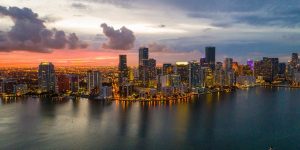Introduction
Meet John Doe, an experienced economist with a focus on real estate markets. With over 20 years of experience analyzing economic trends, John has developed a keen eye for identifying patterns in real estate markets. Today, he shares his insights on the Miami real estate market.
Understanding Miami’s Real Estate Market
Miami’s real estate market has been a hot topic among economists and investors alike. The city’s vibrant culture, beautiful beaches, and booming economy have made it a desirable location for both residential and commercial properties. However, the rapid growth and soaring prices have raised concerns about the sustainability of this trend.
Historical Trends in Miami’s Real Estate
Looking back at the past decade, Miami’s real estate market has seen a significant increase in property values. This growth has been fueled by a combination of factors, including population growth, increased foreign investment, and favorable tax laws. However, the pace of growth has accelerated in recent years, leading some to question whether this is a normal market cycle or a real estate bubble.
Signs of a Real Estate Bubble
A real estate bubble is characterized by rapid increases in property values, fueled by speculation rather than fundamental economic factors. In Miami, several indicators suggest that the market may be in a bubble. These include a high ratio of property prices to rents, an increase in speculative buying, and a significant amount of unsold inventory.

Comparing Miami with Other Real Estate Markets
When compared to other major real estate markets, Miami’s market stands out for its rapid growth and high property values. However, other markets have also experienced similar trends, suggesting that Miami is not alone in its real estate boom. This comparative analysis can provide valuable insights for investors looking to diversify their real estate portfolios.
Potential Impacts of a Bursting Bubble
If the Miami real estate market is indeed in a bubble, and that bubble bursts, the impacts could be significant. Property values could plummet, leaving investors with properties worth less than their mortgages. This could lead to a wave of foreclosures, further depressing property values. The impacts would also be felt by the broader economy, as construction activity slows and consumer spending decreases.
Strategies for Investors in a Bubble Market
For investors in the Miami real estate market, the potential for a bubble burst presents both risks and opportunities. On one hand, a market correction could result in significant losses. On the other hand, it could also present opportunities to buy properties at discounted prices. The key for investors is to stay informed, diversify their portfolios, and be prepared to act quickly if the market changes.
Conclusion
While there are signs that Miami’s real estate market may be in a bubble, the situation is complex and constantly evolving. Economists, financial advisors, and real estate investors should continue to monitor the market closely, taking into account the latest data and trends. As always, the best strategy is one that is informed, diversified, and adaptable to changing market conditions.
Table: Key Points in Miami’s Real Estate Market
| Historical Trends | Signs of a Bubble | Potential Impacts | Strategies for Investors |
|---|---|---|---|
| Rapid growth in property values | High price-to-rent ratio | Potential for property values to plummet | Stay informed and diversify portfolio |
| Increased foreign investment | Increase in speculative buying | Possible wave of foreclosures | Be prepared to act quickly |
| Favorable tax laws | Significant amount of unsold inventory | Impacts on broader economy | Look for opportunities to buy at discounted prices |



